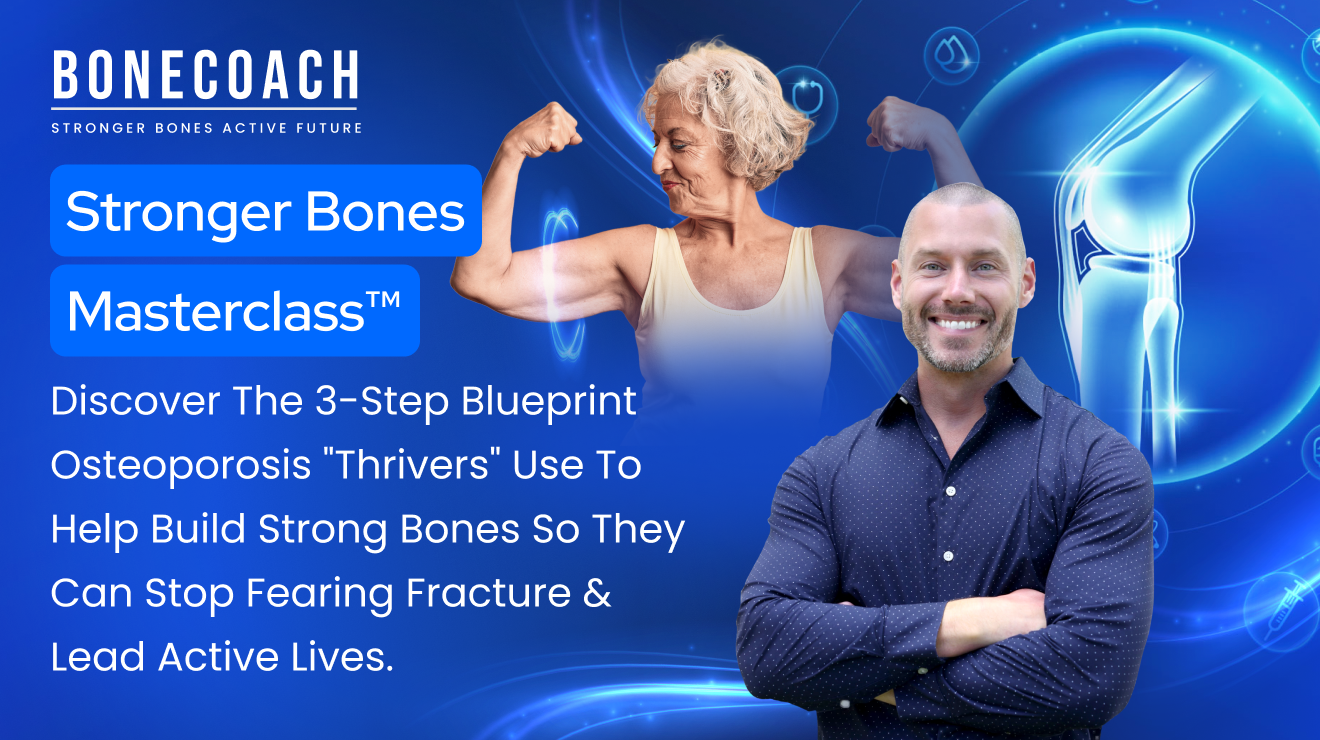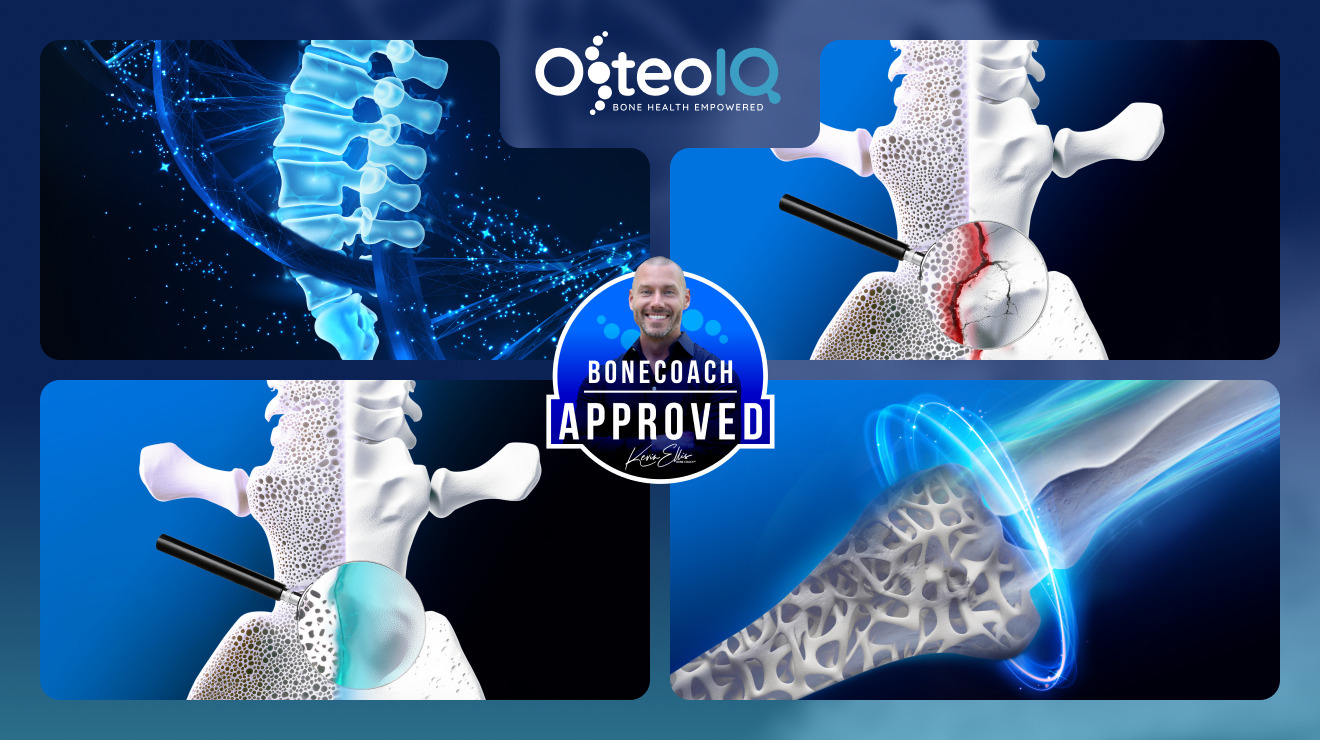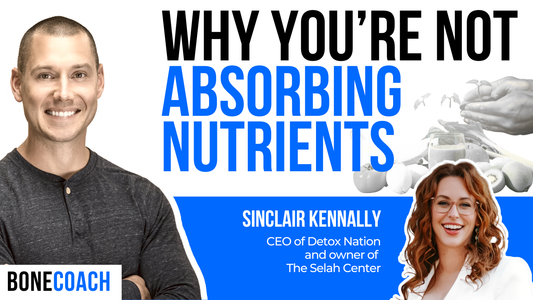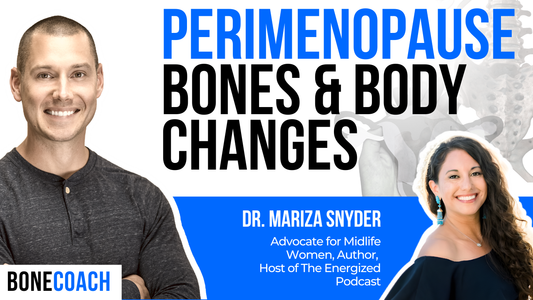In this vlog with Betty Murray, PhD-C, MS, CN, IFMCP, she discusses what mast cells are; how they become activated; and, how mast cells may be playing a role in your bone metabolism and bone turnover.
Mast Cell Activation and Osteoporosis
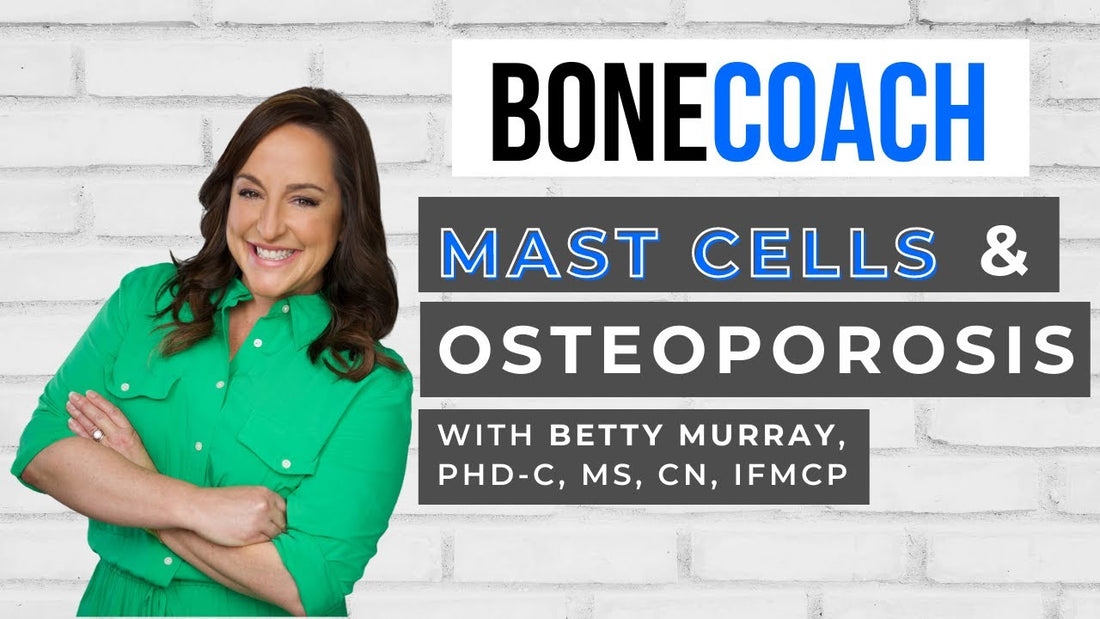
Episode Details
Episode Timeline
- 00:00 Welcome to the BoneCoach Mast Cell, Histamine, and Osteoporosis Vlog and Blog. This is Betty Murray. I'm a PhD candidate and a certified nutritionist and certified functional medicine practitioner through the Institute of Functional Medicine. And I'm going to talk a little bit today about histamine mast cells and their role in osteoporosis.
- 00:28 So let's get to it. For many of you, you may be wondering what the heck is a mast cell. Mast cells are important cells of the immune system that are involved in many physiological and pathological conditions, including things like bone metabolism and bone disorders. Mast cells are located in the bone marrow and they secrete a wide spectrum of mediators.
- 00:52 Think of these as little messengers, which can be rapidly released upon activation. Once the mast cell has become mature. And then it can act on different tissues, like your mucosal barriers or your connective tissues. So said another way, mast cells are part of your immune system response that are first responders to incoming pathogens.
- 01:14 So for instance, if you have allergies and you step outside and you get exposed to pollen, you get a histamine response, which is part of the mast cell activation that is trying to remove that pathogen as seen as the pollen itself, from your system to try and get it off the mucosal barriers. So mast cells mediate a significant portion of our immune response, but mast cells also act on different tissues in different ways.
- 01:43 So what's interesting is when we've looked in studies at mast cells, what they've started to see is that the molecules the mast cells use to communicate (things like histamine and or other inflammatory things like Interleukin-6), actually exert control and activity over the osteo-catabolic activity at the bone.
- 02:06 In other words, the breakdown activity of the bone by promoting osteoclast formation...and they can also inhibit osteoblast activities. So mast cells could potentially act in both a negative way by increasing bone breakdown, but in some ways, they may be able to be osteo-protective by stimulating osteoblasts and by reducing osteoclast growth.
- 02:33 So all that to say, there's a lot of opportunity for research to continue in mast cells and histamine. So let's talk a little bit more about what that means. Mast cells may contribute to the pathogenesis of primary and secondary osteoporosis and other inflammatory conditions and inflammatory diseases like rheumatoid arthritis and osteoarthritis. Because there's increasing numbers of mast cells found in patients.
- 03:03 suffering from these diseases, we know that they may play a role specifically in the actual pathogenesis of those diseases. Mast cells also regulate bone healing after fracture by influencing the inflammatory response toward the fracture itself...mast cells help what they call revascularization, which means your body reproducing or producing more blood vessels to increase blood flow, bone formation.
- 03:30 and calcification. Those are all remodeling processes controlled by osteoclasts. So let's look a little deeper in what's really happening. So mast cells are actually in the tissue. So they actually act in the tissues and they're best known for promoting allergic reactions. However, the research like I disclosed earlier over the last few decades have really implicated mast cells in several other conditions because they regulate things like vascular vessel development.
- 04:04 and tissue homeostasis, which is a fancy way of saying my tissues are being balanced and in balance with the immune system, and other pathological conditions like gastrointestinal disorders and cardiovascular disease. So mast cells are distributed throughout the body and especially in the skeletal system, mast cells are involved in bone metabolite and bone disorders.
- 04:27 Because mast cells store and make a bunch of inflammatory mediators, things like cytokines and enzymes which have been shown to regulate bone balance and bone homeostasis, they are also involved in those pathogenic skeletal diseases. Increasing numbers of mast cells have been found in patients who have reduced bone loss which is observed in conditions like post-menopausal osteoporosis and mastocytosis, which is a mast cell disorder.
- 05:00 Increased number of mast cells have also been found in patients that have menopause-related bone loss as well, where histamine and other inflammatory conditions are effected. So the synovial fluid, which is a fluid around your bones and joints have been found to contain very large amounts of mast cells.
- 05:21 particularly if people have osteoarthritis. These elevated concentrations of mast cells signal, along with other messengers like histamine and tryptase, allergy responses. So the inflammatory cytokines, the histamines and tryptases are part of the mechanism in which the mast cell mediates and controls your immune system.
- 05:43 But those same messengers can affect the bones themselves. So mast cells are also tissue specific. So they produce messengers depending on where they're at in the body to induce particular activities, to help our immune system fight. Those messengers are things like I've mentioned before: histamine, heparin, cytokines, things like tumi necrosis factor alpha, Interleukin-6.
- 06:09 enzymes like tryptase, and growth factors like the vascular endothelial growth factor. So mast cells are not really found in the circulation. They're more so distributed to the actual tissues in which they act. They are released specifically from the bone marrow. So mast cells are part of bone marrow formation, and they start out as immature cells and then they get matured as they're sent to a particular tissue for action.
- 06:38 So while mast cells are located at almost all tissues, high numbers are found in the tissues that face your external environment. So we find a lot of mast cells in the skin, in the lungs, and in the intestines where passage and exposure is high and very likely. Mast cells serve as a immune sort of sentinel, or an immune "cop", to make sure that it can be the first line of defense against.
- 07:06 incoming pathogens...and mast cells last a long time, so they survive for a long period of time. Mast cells also react to the environment depending on the tissue they're in and whether there's damage or not. So mast cells receive information from things circulating in your bloodstream, pathogens and things like that.
- 07:26 And then they also respond to tissue damage. So mast cells can also be activated by other immune cells: things like immunoglobulins, other cytokines, neuropeptides proteins called compliment proteins and things called Pampa, which are pathogen associated, molecular patterns. All of those are mechanisms in which the body.
- 07:49 starts to launch an inflammatory response. So activation of mast cells results in their release of preformed and newly synthesized or newly made mediators things like histamine. And often that happens through the process called de granulation do granulation is literally imagined the mast cell pops open and all of the ingredients pop out of the cell like histamine, but.
- 08:15 They don't always pop open and just drop all of their contents. They may signal with smaller amounts out to the different tissues because mast cells are present at tissue borders, especially things that. Receive a lot of exposure to pathogens. They are the first cells that actually respond to invading pathogens.
- 08:35 Mast cells can also be directed to pathogens and other byproducts made by things like bacteria and other organisms that survive in our body. mast cells can directly kill pathogens. They also enhance mucus production and in our different linings of her body, like the nasal passages, lungs, and intestines meant to immobilize pathogens and they actual modulate [00:09:00] your vascular permeability, your blood flow and they help initiate rapid immune response and rapid immune recruitment of other cells. So your body can actually fight off infection.
- 09:12 So, mast cells are extremely important to initiating the immune response, but they're also critical for immune healing. They are present in the connective tissue.
- 09:22 So things like collagen ligaments, attendance, and the skin, and they can be activated by injury trauma. Radiation or even chemical agents. So it, mast cells are vital to our immune system response, but they can also play a role in the physiological activity of bone turnover. So mast cells are located mostly in the long part of the bone where bone remodeling mainly occurs not right up at the ends or the ends of the bones.
Resources mentioned
Claim your FREE 7-Day Osteoporosis Kickstart here! (the exact information you need to accelerate your path to stronger bones now)
Show notes and resources mentioned: https://bonecoach.com/osteoporosis-mast-cell-histamine
Image Credits:
Copyright: designua
Copyright: rob3000 https://doi.org/10.3389/fimmu.2020.00163
What can you do to support your bone health and this podcast?
1. Subscribe
Hit the “Subscribe” Button on your podcast player (i.e. Apple, Google, Spotify, Stitcher, iHeart Radio, and TuneIn). Never miss an episode that could help to improve your bone health.
2. Leave a review
The more positive ratings and reviews and the more subscribers we have, the more people can find us and get the answers to questions they need. Thank you!
3. Share
Tell a friend about The Bone Coach Podcast or share via text, email, or social. Know of a Facebook group where people could benefit from this info? Feel free to hit one of the share buttons below.
Build Strong Bones.
Live Fearlessly.
Don’t let osteoporosis hold you back. Discover proven solutions to strengthen your bones, reduce fracture risk, and reclaim the active life you love.
Apply to work with
the Bone Coach™ Team
We've helped thousands of people with osteoporosis around the world address bone loss, build bone strength, prevent fracture and injury, and lead active lives.
Professional Grade
Supplements For Stronger Bones Support
Preserve and strengthen the structure
that's going to carry you to an active future. Get started
today and put your bone health on autopilot.
Osteoporosis Testing for Prevention, Monitoring, and Reversal
Discover the lab tests built to help you know if you are winning or losing the fight against bone loss. Know how to adjust in real-time to reach your bone strength goals.
Medical Disclaimer:
The information shared above is for informational purposes only and is not intended to provide medical or nutrition therapy advice; it does not diagnose, treat or cure any disease, condition; it is not to be used as a replacement or substitute for medical advice provided by physicians and trained medical professionals.
If you are under the care of a healthcare professional or are currently using prescription medications, you should discuss any dietary and lifestyle changes or potential dietary supplements use with your doctor. You should not discontinue any prescription medications without first consulting your doctor.
FDA Disclaimer:
The information on this website has not been evaluated by the Food & Drug Administration or any other medical body. We do not aim to diagnose, treat, cure or prevent any illness or disease. Information is shared for educational purposes only. The content of this blog is not intended to be a substitute for professional medical advice, diagnosis, or treatment. Users should not disregard, or delay in obtaining, medical advice for any medical condition they may have, and should seek the assistance of their health care professionals for any such conditions.
You must consult your doctor before acting on any content on this website, especially if you are pregnant, nursing, taking medication, or have a medical condition.
References
- Buckley MG, Walters C, Wong WM, Cawley MI, Ren S, Schwartz LB, et al. Mast cell activation in arthritis: detection of alpha- and beta-tryptase, histamine and eosinophil cationic protein in synovial fluid. Clin Sci. (1997) 93:363–70. doi: 10.1042/cs0930363
- Schubert N, Dudeck J, Liu P, Karutz A, Speier S, Maurer M, et al. Mast cell promotion of T cell-driven antigen-induced arthritis despite being dispensable for antibody-induced arthritis in which T cells are bypassed. Arthritis Rheumatol. (2015) 67:903–13. doi: 10.1002/art.38996
- Kroner J, Kovtun A, Kemmler J, Messmann JJ, Strauss G, Seitz S, et al. Mast cells are critical regulators of bone fracture-induced inflammation and osteoclast formation and activity. J Bone Miner Res. (2017) 32:2431–44. doi: 10.1002/jbmr.3234
- Gurish MF, Austen KF. Developmental origin and functional specialization of mast cell subsets. Immunity. (2012) 37:25–33. doi: 10.1016/j.immuni.2012.07.003
- Okayama Y, Kawakami T. Development, migration, and survival of mast cells. Immunol Res. (2006) 34:97–115. doi: 10.1385/IR:34:2:97
- Urist MR,McLean FC. Accumulation of mast cells in endosteum of bones of calcium-deficient rats. AMA Arch Pathol. (1957) 63:239–51.
- Taniguchi H. Mast cells in fracture healing: an experimental study using rat model. Nihon Seikeigeka Gakkai Zasshi. (1990) 64:949–57.
- Turner RT, Iwaniec UT, Marley K, Sibonga JD. The role of mast cells in parathyroid bone disease. J Bone Miner Res. (2010) 25:1637–49. doi: 10.1002/jbmr.49
- Biosse-Duplan M, Baroukh B, Dy M, de Vernejoul MC, Saffar JL. Histamine promotes osteoclastogenesis through the differential expression of histamine receptors on osteoclasts and osteoblasts. Am J Pathol. (2009) 174:1426–34. doi: 10.2353/ajpath.2009.080871
- Ragipoglu, D., Dudeck, A., Haffner-Luntzer, M., Voss, M., Kroner, J., Ignatius, A., & Fischer, V. (2020). The Role of Mast Cells in Bone Metabolism and Bone Disorders. Frontiers in Immunology, 11, 163. https://doi.org/10.3389/fimmu.2020.00163
